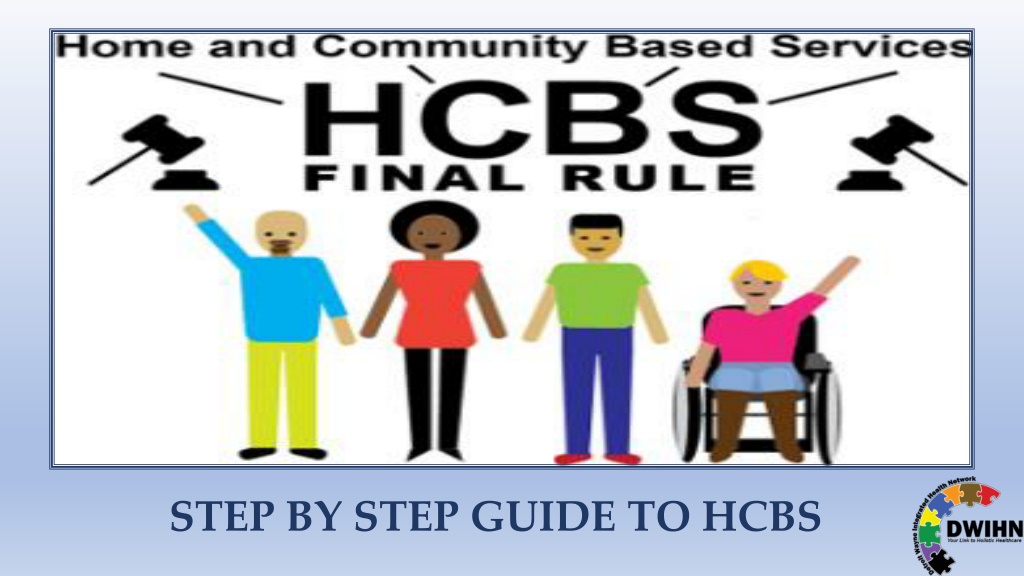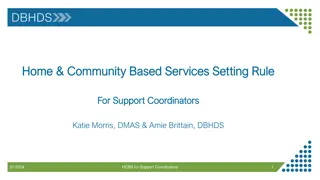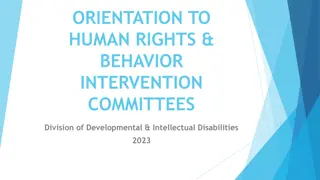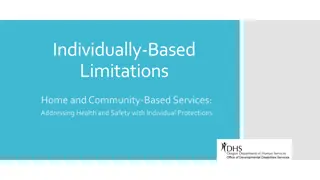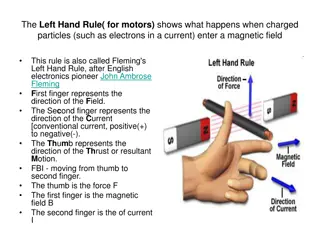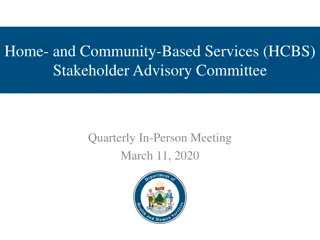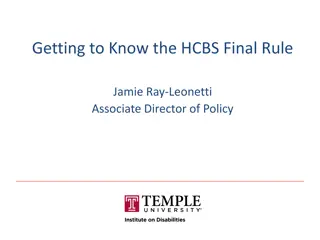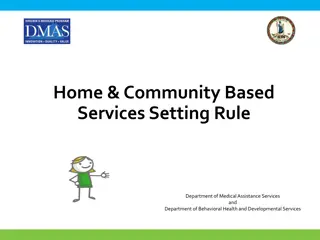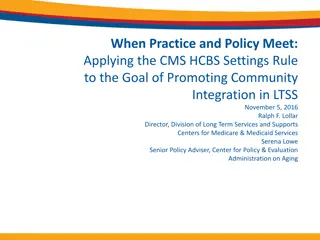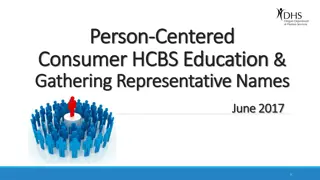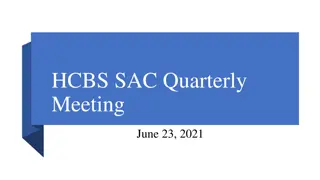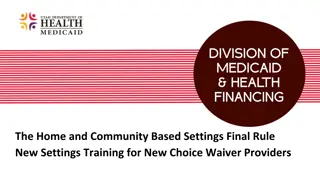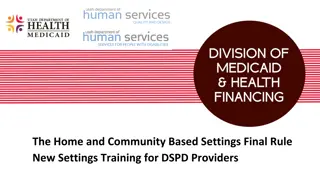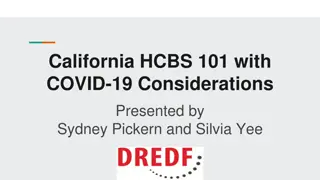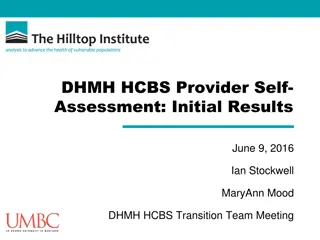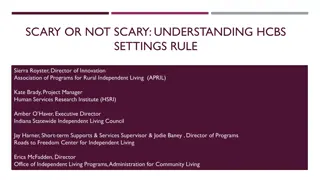Understanding Home and Community Based Services (HCBS) Final Rule
HCBS, which stands for Home and Community Based Services, provides Medicaid services to individuals with disabilities to support independent living. The HCBS Final Rule, implemented in January 2014, ensures individuals' rights to privacy, dignity, and choice in their living arrangements and community participation. The goal is to promote independence, community engagement, and respect for individual rights through HCBS services.
Download Presentation

Please find below an Image/Link to download the presentation.
The content on the website is provided AS IS for your information and personal use only. It may not be sold, licensed, or shared on other websites without obtaining consent from the author. Download presentation by click this link. If you encounter any issues during the download, it is possible that the publisher has removed the file from their server.
E N D
Presentation Transcript
What is HCBS? HCBS stands for Home and Community Based Services. These are Medicaid services for people with disabilities, to help them live in their own homes and communities.
Who is HCBS for? HCBS services are for Medicaid eligible people with disabilities such as intellectual or developmental disabilities, physical disabilities, and/or mental illnesses.
What are HCBS services? The following services are Home and Community Based Services: Assistive Technology Community Living Supports Enhanced Pharmacy Environmental Modifications Family Support & Training Fiscal Intermediary Services Housing Assistance Peer-delivered or -Operated Support Services Respite Care Skill-Building Assistance Supported/Integrated Employment Support and Service Coordination These services are also called B3 Supports and Services and can be found in the Behavioral Health and Intellectual and Developmental Disability Supports and Services chapter of the Medicaid Provider manual
HCBS Final Rule In January 2014, the Centers for Medicare and Medicaid Services (CMS) announced a Final Rule on HCBS. The HCBS Final Rule protects an individual s right to privacy, dignity, respect and freedom. It protects the right for individuals to make choices about where to live and work, and how to be a part of their community.
Purpose HCBS Final Rule The goal of the HCBS Final Rule is to make sure that the services individuals receive, give people the opportunity for independence in making life decisions, to fully participate in community life, and to ensure that individuals rights are respected.
What is the HCBS Final Rule? The HCBS Final Rule requires that all settings that provide HCBS funded services must meet specific criteria in order to continue to receive that funding. All service providers need to be incompliance with the HCBS Final Rule by March 17, 2023. The rule applies to all settings in which HCBS are delivered, not just residential settings, however this PowerPoint is focused only on residential settings.
HCBS Setting Criteria Let's look at the specific criteria providers must meet in order to continue to receive HCBS funding. First, The Physical Location of the Setting criteria: The setting must be integrated in the community, providing full access to the benefits of community living It can not be institutional in nature It can not be isolating or segregating
HCBS Setting Criteria Second, Supporting the Rights and Freedoms of Individuals criteria: Ensure individuals who have disabilities have the same access to the community as individuals who do not have disabilities. Allow individuals the opportunity to make decisions about the services they receive and who provides their services.
HCBS Setting Criteria Supporting the Rights and Freedoms of individuals criteria (cont.): Provides opportunities to seek employment and work in competitive integrated settings, engage in community life, and control personal resources Is selected by the individual from among setting options, including non-disability specific settings and an option for a private unit in a residential setting
HCBS Setting Criteria Supporting the Rights and Freedoms of individuals criteria (cont.): Ensures an individual s rights of privacy, dignity, respect, and freedom from coercion and restraint Optimizes individual initiative, autonomy, and independence in making life choices
HCBS Residential Setting Criteria The HCBS Final Rule requires that provider owned or operated/controlled residential settings honoran individual s right to privacy, dignity, respect and freedom; and provides opportunities for individuals to make choices about where to live and work, and how to be a part of their community. A provider-owned and controlled setting is a setting that is owned and controlled by a Prepaid Inpatient Health Plan, Community Mental Health Service Provider, or contracted provider. A residential setting may be provider-owned and controlled if the participant lives in a private residence that is owned or controlled by the Prepaid Inpatient Health Plan, Community Mental Health Service provider, or the contracted provider. Controlled means the person accepts the provider's staff as part of the living arrangement - provider controls the choice of who delivers the direct services in a package deal.
HCBS Residential Setting Criteria Specifically, the HCBS Final Rule requires that provider owned or operated/controlled residential settings ensure the following: Each individual has privacy in their sleeping or living unit Units have lockable entrance doors, with the individual and appropriate staff having keys to doors as needed Individuals sharing units have a choice of roommates Individuals have the freedom to furnish and decorate their sleeping or living units within the lease or other agreement Individuals have freedom and support to control their schedules and activities and have access to food any time Individuals may have visitors at any time Setting is physically accessible to the individual
Person-Centered Planning & HCBS The HCBS Final Rule means that the people you support have the right to make choices about where to live and work, and how to be a part of their community. During the person-centered planning process, you will assist the individual by discussing options for where to live, including non-disability specific settings, where to work (if desired), and how the individual would like to participate in their community. These choices are then documented in the IPOS.
Person-Centered Planning & HCBS The reason this is documented in the IPOS is because Federal regulations require it to be. 42 CRF Part 441.301(c)(2)(i) states in part that the Person- Centered Service Plan must reflect that the setting in which the individual resides is chosen by the individual.
Person-Centered Planning & HCBS A note about individuals who have court appointed guardians. For individuals whose guardian has been granted the authority (or power) by Probate Court to make decisions regarding where the individual will live and what programs and activities they will participate in, the options are discussed with the individual and guardian during the person-centered planning process, and the individual / guardian's choices are then documented in the IPOS.
Person-Centered Planning & HCBS For individuals who can not communicate in a way that is understood by others and the member has a guardian / legal representative who speaks on their behalf, the guardian / legal representative responses to the HCBS questions are to be documented in the IPOS. Do not respond "No" to the HCBS questions with an explanation that the member can not communicate a response. Doing so suggests the member is being denied choices about where they live and the supports they receive.
HCBS Section of IPOS The standardized IPOS was re-designed to assist with documenting the HCBS requirements. The questions in the HCBS Section of the IPOS are designed to make sure all of the HCBS Final Rule requirements are documented in the IPOS so the plan of service meets federal and state regulations and most importantly, clearly identifies the individual's choices in one comprehensive document.
Completing the HCBS Section in the IPOS The remainder of this PowerPoint will identify how to complete the HCBS section of the IPOS. Let's begin with identifying which members you support need to have this section of the IPOS completed.
Completing the HCBS Section in the IPOS The HCBS section of the IPOS needs to be completed for those individuals who reside in a provider owned or operated/controlled settings and receive HCBS services. Parents' Home Other Family Member Home Rental or Lease agreement with a Non-Provider entity or individual Residential settings Licensed & unlicensed AFC Homes SIL / SIP HCBS Section of IPOS
Completing the HCBS Section in the IPOS . . . and have a need for and or receive one or more of the following HCBS services listed below: Assistive Technology Community Living Supports Enhanced Pharmacy Environmental Modifications Family Support & Training Fiscal Intermediary Services Housing Assistance Peer-delivered or -Operated Support Services Respite Care Skill-Building Assistance Supported/Integrated Employment Support and Service Coordination
Completing the HCBS Section in the IPOS This is how the section starts in the IPOS. View in MH-WIN When the Yes button is selected, the IPOS will expand with a set of questions regarding HCBS requirements.
Completing the HCBS Section in the IPOS There are the 12 questions that address the HCBS requirements. Each question must receive a Yes or No response. View in MH-WIN
Completing the HCBS Section in the IPOS Now let's look at each individual question and the best way to respond to each. It is helpful to remember that the intent of the questions is to document that the individual, or their legal guardian, was informed of options and choices available to them and whether or not the individual / legal guardian exercised their right to choose. First Question . . .
HCBS Section of IPOS Were housing options explained and offered to the member (including non- disability specific settings and for residential settings)? The IPOS must reflect what housing options were discussed with the individual (or legal guardian where applicable). If the member is unable to communicate in a way that others can understand and has a legal guardian with the authority to make housing choices and housing options were explained to the guardian yes is the appropriate response. If the member or guardian responds No , then an explanation must be provided. For example, emergency housing might be an explanation why options were not discussed. Any time that we are not meeting the standard (i.e., a question is answered "No"), the plan needs to include a goal to address or correct the area of non-compliance with the HCBS Final Rule. In this case, there would need to be a goal to provide the individual / guardian with the housing options, including non-disability settings, available to the member. All No responses will also require an explanation documented in the next set of HCBS questions auto- populated in the plan (explained on slides 49 57).
HCBS Section of IPOS Courtesy Reminder: All goals / objectives need to be time limited. When addressing HCBS requirements, the time frame for completion needs to be reasonable. For example, the time frame for providing housing options should not be the entire plan year. It is unreasonable to take 12 months to provide housing options available to a member. This information should be provided and discussed within a month or two.
HCBS Section of IPOS Did you choose where you live? The IPOS must reflect that the individual (guardian) has chosen the home in which he or she resides. Per regulations, the IPOS must also reflect that the home was selected by the member from among a variety of setting options, and for residential settings, consistent with the individual s available resources to pay for room and board. If member has a guardian that has legal authorization to make housing decisions and the guardian chose the home the individual resides in - yes is the appropriate response. If member/guardian states no, then an explanation must be documented and a goal developed to ensure the member (guardian) chooses the home they live in. No responses will also require an explanation documented in the next set of HCBS questions auto-populated in the plan.
HCBS Section of IPOS Are you satisfied with your current housing? The IPOS must reflect if the individual is satisfied with their housing / living arrangement If the individual has a legal representative who has the authority to make decisions regarding where the member resides, their satisfaction should also be assessed and documented. If the member is unable to communicate in a way that others can understand and has a legal guardian who speaks on their behalf, the guardian's assessment of the individual's satisfaction should be assessed and documented. The home owner or house manager s assessment of the member s satisfaction does not meet this HCBS requirement. If the individual (or guardian) responds No , an explanation for their dissatisfaction should be documented and a goal should be developed to resolve/improve the member s satisfaction , which may or may not include obtaining new housing. No responses will also require an explanation documented in the next set of HCBS questions auto-populated in the plan.
HCBS Section of IPOS I like my roommates The IPOS must reflect if the individual is satisfied with their roommate If the individual has a guardian who has the authority to make decisions regarding the member's living arrangements, their satisfaction should also be assessed. If the member is unable to communicate in a way that others can understand and has a legal guardian who speaks on their behalf, the guardian's assessment of the individual's satisfaction should be assessed and documented. The home owner or home manager s assessment of the member s satisfaction does not meet this HCBS requirement. If the individual or authorized legal representative indicates No , then a goal should be developed to resolve / improve the member/authorized legal representative's satisfaction, which may or may not include obtaining a new roommate or a single room. No responses will also require an explanation documented in the next set of HCBS questions auto-populated in the plan. If the individual has a single room / no roommates - Yes is the appropriate response (because the HCBS requirement for right to choose is not being restricted).
HCBS Section of IPOS I can choose my roommates The IPOS must reflect that the individual (guardian) has chosen their roommate(s) In some circumstances, there may be limited beds available at the home and if the member chooses that setting, they may be choosing that bed without the ability to choose a roommate. In these situations, Yes is the appropriate response. However, the member / guardian's satisfaction with this living arrangement should be assessed throughout the plan year. If member has a guardian / legal representative that has the authority to speak on behalf of the member and they selected the roommate(s) - Yes is the appropriate response. If the member/guardian states No , then an explanation must be documented and a goal to ensure the member (guardian) is allowed to choose their roommate(s). No responses will also require an explanation documented in the next set of HCBS questions auto-populated in the plan. If the individual has chosen a single room - Yes is the appropriate response (because the HCBS requirement for right to choose is not being restricted). Note: Individuals must be aware of the process to request a different roommate or to change from a shared to a private room.
HCBS Section of IPOS I can choose to close and lock my bedroom/bathroom door. Does the home have bedroom and bathroom doors that are lockable by the individual? A lockable door is a side-hinged, permanently mounted door that is equipped with positive-latching, non- locking-against-egress hardware. The hardware must be able to be opened from the inside of a room with a single motion; such as a turn of a knob or push of a handle, even if the door is locked.
HCBS Section of IPOS I can choose to close and lock my bedroom/bathroom door. The IPOS must reflect if the bedroom and bathroom doors are lockable. If the member has a private bedroom, that includes a private bathroom, only the main door to the bedroom needs to be lockable. If there are no locks on a member s bedroom and/or bathroom doors, the response should be No and an explanation must be documented in the next set of HCBS questions auto- populated in the plan. If there is no justified medical/behavioral reason for a lack of locks on the doors, a formal IPOS goal resolving the modification to the HCBS Rule is required. If locks have been removed for behavior management, BTPRC approval & oversight is required and the IPOS should include a goal / objective addressing the behavior treatment plan. It is not sufficient for a member/guardian to state that they do not want locks on the doors. A member does not have to use the locks on the doors, but lockable doors are still a requirement of the HCBS Finale Rule (right to privacy).
HCBS Section of IPOS I can eat snacks/meals when and where I want. The IPOS must reflect if the individual is able to eat when and where they want If the individual is on a special diet (i.e., low sodium / low carb. /Gluten-free / pureed) ordered by a medical professional (MD, Nutritionist), that restricts when and / or where the individual is able to eat, the response will be No and the explanation (medical need) is to be documented in the next set of HCBS questions auto-populated in the plan. If the individual is tube fed as ordered by a medical professional (MD, Nutritionist, SLP), that restricts when and / or where the individual is able to be fed, the response will be No and the explanation (medical need) is to be documented in the next set of HCBS questions auto-populated in the plan. If the medically prescribed diet does NOT restrict when and where the individual eats / is fed, than Yes is the appropriate response.
HCBS Section of IPOS I can eat snacks/meals when and where I want. (cont.) The IPOS must reflect if the individual is able to eat when and where they want If there is no evidence of a medical order / SLP order for the special diet, a goal will need to be developed to determine whether the diet is medically needed / approved or should be discontinued. Exception: If the individual is voluntarily dieting / limiting when and where they can eat and this plan is not enforced by the home staff, score the question as Yes and determine if a goal is needed to have a medical professional monitor the individual s dieting.
HCBS Section of IPOS I can eat snacks/meals when and where I want. (cont.) Exceptions: If access to food is restricted due to a housemate s behaviors / medical condition, and the individual has consented to reside in the home with the restrictions, Yes is the appropriate response (because the individual s choice was not limited). The plan does need to identify what accommodations the home has in place to provide the individual access to food.
HCBS Section of IPOS I can decorate my bedroom the way I want. Does the home allow the individual to furnish and decorate / personalize their room as desired? Note: some residential / rental / lease agreements may have restrictions regarding room decorating such as, no nails in walls or ceilings. If such a restriction is included in the residential / rental / lease agreement signed by the individual / legal representative, then it is not considered a modification to the HCBS requirements yes is the appropriate response.
HCBS Section of IPOS I can have visitors at any time. Does the home allow the individual to have family and friends to the home at any time of the day and night? If there are time of day restrictions for visitors and or people excluded from being permitted to visit at the home, the response will be No and the justification is to be documented in the next set of HCBS questions auto-populated in the plan. The IPOS should include a goal / objective addressing the restricted visiting hours and or excluded visitors. If for behavior management, BTPRC approval & oversight is required.
HCBS Section of IPOS I attend a place of worship of my choice. Does the home provide opportunities for the individual to participate in spiritual activities of their choice outside the home if the individual chooses to do so? If the individual chooses not to participate in spiritual activities, score the question Yes (The HCBS requirement for right to choose is not being restricted). If participation of spiritual activities is limited, score the question No and an explanation must be documented in the next set of HCBS questions auto-populated in the plan. A goal to resolve the limitation should also be developed in the plan.
HCBS Section of IPOS I attend community/recreational events as often as I want. Does the home provide opportunities for the individual to participate in community / recreational activities of their choice outside the home if the individual chooses to do so? If the individual chooses not to participate in the community, Yes is the appropriate response (The HCBS requirement for right to choose is not being restricted). If the individual is bedridden, Yes is the appropriate response (The HCBS requirement for right to community access is not being restricted). If participation in community / recreational activities is limited, score the question No and an explanation must be documented in the next set of HCBS questions auto- populated in the plan. A goal to resolve the limitation should also be developed in the plan.
Modifications to HCBS Final Rule If any of the HCBS questions are answered No , this means that a criteria or requirement of the HCBS Final Rule is not being met. No responses are often called Modifications to the HCBS Final Rule.
Modifications When a criteria or requirement of the HCBS Final Rule is not being met, or in other words, when there is a modification to the HCBS Final Rule, we need to explain (or justify) the reason why in the IPOS. Modifications must be: Supported by specific assessed need Justified in the person-centered service plan Documented in the person-centered service plan A modification can only be used to maintain health or safety.
Modifications When the No response is selected for any of the HCBS questions, a text box will open for an explanation. Example of an open text box Reminder: The reason for the limitation must be based on medical necessity and an assessed need.
Modifications The reason this is documented in the IPOS is because Federal regulations require it to be. 42 CRF Part 441.301(c)(2)(Xiii) states in part that the Person- Centered Service Plan must document and justify any modification of the HCBS conditions and must be supported by a specific assessed need.
Modifications Important Note: Any restriction / limitation or modification to the HCBS Final Rule that has been put into place for behavior management / behavior control, BTPRC approval & oversight is required.
Completing the HCBS Section in the IPOS The DWIHN standardized IPOS was re-designed to assist with documenting the required information when there are modifications to the HCBS requirements.
HCBS Section of IPOS When the No box is checked for any of the HCBS Questions the IPOS opens up another set of questions to answer. The purpose of the additional questions is to document the justification for any modifications to the HCBS requirements, i.e., No responses.
HCBS Section of IPOS Generated with No Responses Here is a view of the secondary set of HCBS questions that must be answered when there is a No response to the initial set of HCBS questions. View in MH-WIN
HCBS Section of IPOS Generated with No Responses Lets take a closer look at each question and the best way to respond to each. It is helpful to remember that the reason for modifications to the HCBS requirements must be based on medical necessity and an assessed need. The needs may be due to a medial condition and or behavioral. First question . . .
HCBS Section of IPOS Generated with No Responses What is the HCBS right or freedom of movement that is being restricted? What HCBS criteria is not being met or is being limited or denied? Identify the question in the HCBS Section of the IPOS that was responded to with a No answer. Is it choice of housing/roommate, privacy (locks on doors), community access/participation? If there was more than one No response, list all of them here.
HCBS Section of IPOS Generated with No Responses What is the HCBS right or freedom of movement that is being restricted? (cont.) The following responses are not acceptable: No rights are being restricted. [Member] does not have the ability to express certain wants. None or N/A N/A Locks did not come on the doors. If one of the questions in the HCBS Section of the IPOS was responded to with a No answer, than one of the HCBS requirements is being restricted / limited and justification must be documented in the IPOS.
